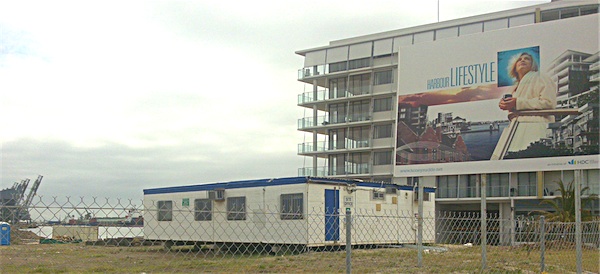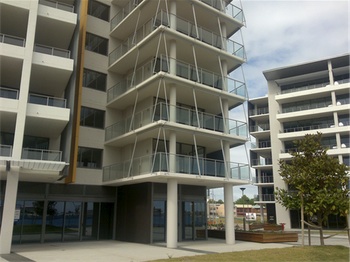“That ‘This is Not Art’ thing this weekend, it’s like a fucking freak show walking past,” says the old guy in the yellow-tiled front bar of The Clarendon Hotel.
It’s just gone noon on Saturday. Apart from ’Pong and I having a burger and beer, he’s the only customer. His worldview of what Newcastle‘s Hunter Street should be like is challenged by the stream of paste-white black-clad comic fans, straggly-bearded eco-hippies, random hipsters and nose-ringed alternagothpunkteendykes strolling past the boarded-up shopfronts.
Noticing a skinny guy wearing yellow overalls and a torn red-striped t-shirt, our frowning drinker puts down his VB. “Hey, is there a circus in town? Because I can see a clown”, he calls out to the barman.
The barman smiles politely, but says nothing.
“Hey, is there a circus in town?”, he mutters, and takes another sip. He looks out at the soulless office buildings that replaced the landscape of his memory, in silence.
Yet these weird out-of-towners, with their experimental robotics, knitting and YouTube mashups, have brought more life to this industrial city’s ailing heart than any grandiose “development” plan.
As night falls they, like us, wonder why there’s virtually nowhere to eat. One Balinese restaurant, full up. One café, the Bogie Hole — named after a nearby ocean rock bath and not what you just thought — stays open to a decadent 8pm. On a Saturday. Then the streets empty. Suburban pubs close and disgorge drunken hordes, who then flood to CBD beer barns to drink even more, fight, vomit and stagger home.
Next morning, we see how Newcastle reckons it’ll save itself. Ah, Honeysuckle! “The Hunter’s premier waterfront playground.”
It’s exactly like every other premier waterfront playground everywhere else. Boxy big-windowed apartment blocks, distinguishable from each other solely by the colour of the concrete panels, or perhaps the angle of the posts supporting motorised canvas awnings.
At ground level, such unique features as umbrellas bearing the names of Italian beers, a Hog’s Breath Café, a Subway store, a bar called “isobar” in lower case.
Honeysuckle is an historical precinct, we’re told by a standard premier waterfront playground historical interpretation sign, black type on burnished steel. In one small area, an old railway track peers out, sitting flush with the colour-matched concrete paving. History as decoration.
Two floors up, a blond boy maybe eight years old has breakfast with his younger blonde sister, sitting on blond-wood designer chairs at a blond-wood designer table while their platinum-blond mother flips through the catalogs. Perhaps there’s just one more thing she needs to buy to complete her perfect premier waterfront lifestyle.
Later she, or her clone, in khaki cargo pants and a Quicksilver hoodie drinks white wine at a premier waterfront playground café with half a dozen identical premier waterfront playground friends.
Outside, tugboats shepherd the 75,000-ton Panama-flagged bulk carrier Energy Trade and another fifty thousand tons of coal out of the world’s busiest coal-shipping port, bound for Yokkaichi, Japan. Another, the Cypriot Pedhoulas Merchant, leaves less than two hours later for Tachibana. The empty 150,000-ton Hanjin Madras is brought in to take their place.
Marcus Westbury, who founded This Is Not Art a decade ago to showcase independent, emerging and experimental art, tells me there’s no residential real estate slump here. Expensive residential properties like Honeysuckle are being built and occupied, but they’re clustered around an empty commercial core.
“There’s one big problem with how Newcastle’s been thinking about how it’s going to fix itself: that some big mega thing will arrive fully formed and make that end of town interesting,” he says.
The Fix Our City consortium, for instance, supports a plan to rip out the railway to Newcastle station that separates the old CBD from the waterfront and replace it with a massive new development. The developers wave some push-poll claiming “93% of the public agreeing with the need for change.”
Naturally, they want NSW government support.
As an outsider, I can’t help but think deliberately destroying a working, historic transport link is nothing but a land grab.
Meanwhile, Westbury has been showing us Renew Newcastle. Frustrated with seeing buildings lay empty for years, he founded this project to organise artists, cultural projects and community groups to use and maintain these buildings under license until they’re commercially viable or redeveloped. So far it’s supported three dozen projects ranging from craft and fashion galleries to an animation studio and a tea house.
“The barrier to entry is capital,” says Westbury, noting that urban development processes are geared to big projects. “If you make it possible for people who don’t have money to be able to do things, then a whole new range of things become possible.”
On Sunday afternoon, eighty people packed Renew Newcastle’s HQ, the deconsecrated St Mark’s Catholic Chapel, to learn Westbury’s methods. Expect to see similar projects in a run-down urban environment near you.
[This article was originally written for Crikey — which explains the “mainstream media style” in parts — but it was bumped when a far more newsworthy Letter from The Phillippines arrived, chronicling the country’s terrible natural disasters. This is an edited and expanded version.]



there’s some more places to eat on darby st but it’s a few blocks from the centre of town. and I found some on beach-side of the hunter st mall too. but yeah, food choices are a bit dismal in town if the cafe’s closed. rain didn’t help. but at least the festival was good.
I used to live in Newcastle. I now live in Sydney. This article pretty much sums up the reasons I left. What a shit of a place.
D.
@kath: Yes, the Festival was excellent, and I may well write something about that too. Thanks for the food-hunting tips.
@Dylan Lindgren: Hmmm… I’d hoped this to be a more positive piece, pointing to the innovation coming from the bottom up through projects like Renew Newcastle rather than the top down, and to at least one industry that’s still thriving, namely coal.
But Steve Remington also picked up on the negative vibe:
Maybe I’ll have to re-visit my notes and provide a different spin…
Sorry, I was only talking about the parts where you said what was wrong with Newcastle and I’m sure that’s what Steve was talking about too. The empty shops, violent streets and general idiocy from the whole of the Newcastle City Council. That’s why I left. Its good what Renew Newcastle are doing and I hope they succeed… they’ll need all the help they can get if they want to overcome the stifling actions of the Newcastle Conservative Council.
@Dylan Lindgren: Nothing to be sorry about, Sir. I do indeed describe some negative aspects of “traditional” Newcastle. And there are plenty of them.
Reflecting on how this essay was written, I can see that the burghers of Newcastle are falling for a logical fallacy.
They’re looking at the results and symbols of success and imagining that they’re the causes of success.
I think this is exactly the same as Marcus’ point about “the big mega thing” looked at another way.
I agree that TINA and Renew Newcastle have been saving graces for Newcastle and that the City Centre should not just be an extra big suburban shopping mall. In fact I’d prefer the industrial wasteland to the suburban shopping mall. Those places are really depressing. (Also look at any city without a train — what a hole! Even if not many people use it now, you’ll regret it in 10 years if you take the train out.)
@Bill: The thing that strikes me as stupid about the remove-the-train plan is that you’d end up having the big mega shopping centre but then dump out-of-towners a full 4km or 5km short of it, at Hamilton or Broadmeadow. Why would tourists then transfer to buses or light rail to the Newcastle CBD instead of just catching the next train up the Hunter Valley to a comfortable winery?
That, more than anything else, makes me think it’s nothing but a land grab.
I have to agree with Dylan that your piece did depress me. I am from Sydney but my husband is Novocastrian and it’s my ideal plan to move to Newie sometime in the future. Yes there’s a lot wrong with Newcastle in terms of it maintaining relevance in an increasingly commercial, generic, shopping centre, big development kind of way but there’s so much potential to capitalise on all the great things about it, like the vintage CBD and beaches and old-school vibe without completely destroying it. But one wrong turn and it could be all over red rover. Just one big bad Chatswood 2 hours north of Sydney. Marcus demonstrates the exact kind of creativity that city needs to succeed.
Obviously both of you have moved there. Given the need, how could you not, in good faith?
Oh right, it’s a pity only poor people with no options should move to, in the hope of something BIG happening. Not empowered folk such as yourself.
@Amos Keeto: I get your point, I think. We expect someone else to fix up the problems, whether that’s the government or some other unexplained “them”. I’m old enough to remember when organisations like Rotary and Lions proudly built facilities like playgrounds. I see they both still exist, but I wonder how they’re faring? Now, well, we work hard, pay taxes and just expect things to be done for us.
And yet…
“Poor people with no options” sounds just like the desperate people with drive who decided to emigrate and found the United States, or the non-convict colony of South Australia. The comfortable have no need for such exertion. Maybe it has always been thus.
To your point Stilgherrian, maybe Newcastle should stop trying to make itself ‘better’. In my mind it’s great the way was, and that the newer developments set to ‘improve’ it have done the opposite. Perhaps the comfortable have no need for exertion, because they like it how it is and don’t care for change.